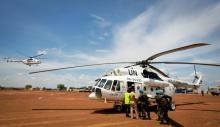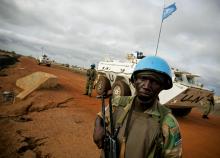MINUSMA, MALI
The United Nations Multidimensional Integrated Stabilization Mission in Mali (MINUSMA) was established by Security Council resolution 2100 of 25 April 2013 to support political processes in that country and carry out a number of security-related tasks. The Mission was asked to support the transitional authorities of Mali in the stabilization of the country and implementation of the transitional roadmap.
More Information: https://peacekeeping.un.org/en/mission/minusma
UNIFIL, LEBANON
Originally, the Unated Nations Interim Force in Lebanon (UNIFIL) was created by the Security Council in March 1978 to confirm Israeli withdrawal from Lebanon, restore international peace and security and assist the Lebanese Government in restoring its effective authority in the area. The mandate had to be adjusted twice, due to the developments in 1982 and 2000.
MINUJUSTH, HAITI
The mandate of the United Nations Mission for Justice Support in Haiti (MINUJUSTH) is set out in the Security Council Resolution 2350 (2017), which was adopted on 13 April 2017. It provided for the establishment of a peacekeeping mission in Haiti that would begin operations upon completion of the mandate of the United Nations Stabilization Mission in Haiti (MINUSTAH).
More information: https://peacekeeping.un.org/en/mission/minujusth
UNMISS, SOUTH SUDAN
On 9 July 2011 South Sudan became the newest country in the world. In adopting resolution 1996 (2011) on 8 July 2011, the Security Council determined that the situation faced by South Sudan continued to constitute a threat to international peace and security in the region and established the United Nations Mission in the Republic of South Sudan (UNMISS) to consolidate peace and security and to help establish conditions for development.
More information: https://peacekeeping.un.org/en/mission/unmiss
UNDOF, GOLAN
From early March 1974, the situation in the Israel-Syria sector became increasingly unstable, and firing intensified. The United Nations Disengagement Observer Force (UNDOF) was established on 31 May 1974 by Security Council resolution 350 (1974), following the agreed disengagement of the Israeli and Syrian forces in the Golan. More Information: https://peacekeeping.un.org/en/mission/undof
UNISFA, ABYEI
The Security Council, by its resolution 1990 of 27 June 2011, responded to the urgent situation in Sudan’s Abyei region by establishing the United Nations Interim Security Force for Abyei (UNISFA). The Security Council was deeply concerned by the violence, escalating tensions and population displacement.
More information: https://peacekeeping.un.org/en/mission/unisfa
MINURSO, WESTERN SAHARA
The United Nations Mission for the Referendum in Western Sahara (MINURSO) was established by Security Council resolution 690 of 29 April 1991. The settlement plan, as approved by the Security Council, provided for a transitional period for the reparation of a referendum in which the people of Western Sahara would choose between independence and integration with Morocco.
More Information: https://peacekeeping.un.org/en/mission/minurso
Green Room
The green room is a space located on the 2nd floor behind the press briefing room for speakers to prepare before addressing the press. It’s a narrow rectangular office space with west facing windows.
The Dag Hammarskjöld Library
At the southwest corner of the United Nations grounds, linked to the Secretariat Building, is the Dag Hammarskjöld Library dedicated on 16 November 1961 in honour of the late Secretary- General. The building was erected to meet the Organization's growing demands for library services and its construction was made possible by a gift of $6.6 million from the Ford Foundation. It was designed by the firm of Harrison, Abramovitz and Harris, architectural consultants to the United Nations.
Trusteeship Council
The Trusteeship Council, one of the main organs of the UN, was established to supervise the administration of trust territories as they transitioned from colonies to sovereign nations. The Council suspended its activities in 1994, when Palau, the last of the original 11 trust territories, gained its independence.
The Chamber, originally designed by Danish architect Finn Juhl in 1952, has been revamped in a close collaboration between the UN and the Government of Denmark, with new furniture by Danish designers Kasper Salto and Thomas Sigsgaard.















































